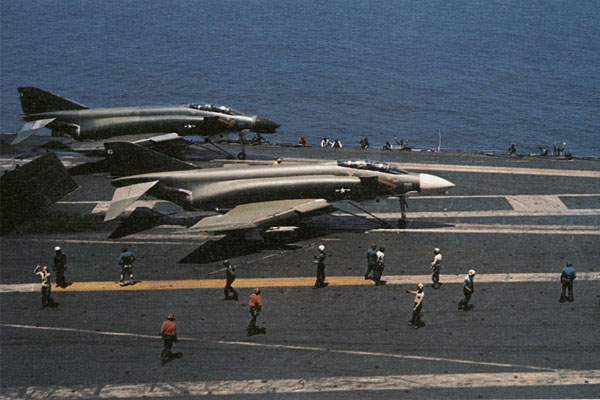Initializing...
The Fighting Black Lions of VF-213 were commissioned as a Navy Fighter Squadron on 22 June 1955 at NAS Moffett Field, California. The Black Lions flew the F-2H3 Banshee during their first deployment aboard USS BON HOMME RICHARD (CV-31),then transitioned to the F-4D Skyray for their next two deployments on USS Lexington (CV-16). By their third WEST PAC deployment aboard the “LEX,” they were flying the F-3H2 Demon, giving the squadron their first capability with the newly released AIM-7 Sparrow air-to-air missile. In June 1961, the squadron moved to its new home at NAS Miramar -- “FIGHTERTOWN USA.” Three years later, in February 1964, the Black Lions took a quantum leap forward in fighter capability by accepting the first of their new F-4 Phantoms. In November 1965, VF-213 joined Carrier Air Wing 11 (CVW-11) and began the first of six combat deployments to Southeast Asia aboard USS Kitty Hawk (CV-64).  This deployment marked the first use of the Phantom as a conventional bomber--a role destined to make the Phantom a mainstay of the US Navy, Air Force and Marine Corps. Over the next seven years, the Black Lions flew over 11,500 combat missions and delivered over 6,000 tons of ordnance. On 20 December 1966, LT D. A. McRae and ENS D. N. Nichols downed an enemy AN-2 Colt for the squadron’s first kill. In March 1971, VF-213 became the first fleet squadron to fly the Phantom more than 1,000 hours in a single month. In December 1976, VF-213 transitioned to the Navy’s premier supersonic fighter -- the F-14A Tomcat. April 1982 found a new mission for the Black Lions when they began training with the Tactical Air Reconnaissance Pod System, or TARPS.  In September of that year, the squadron began their first deployment aboard USS Enterprise (CVN-65). During Indian Ocean Operations, the Black Lions again set the standard by flying the longest tasked carrier flight for a Tomcat when they completed a 1,775-mile TARPS mission. During WESTPAC ‘88, the Black Lions took an active role in ensuring the safe transit of re-flagged tankers through the Persian Gulf and the Straights of Hormuz. That same deployment saw VF-213 in action in the Operation Praying Mantis naval conflict with Iran on 18 April 1988. The Black Lions won the prestigious “BOOLA BOOLA” award in March 1989 for their aggressive professional completion of all missile test firings. That fall, VF-213 and CVW-11 went around the world on USS Enterprise's final WESTPAC deployment, dropping her off in Norfolk, Virginia for refurbishment. In September 1990, VF-213 and CVW-11 went back to the shipyards of Norfolk, Virginia, to embark on the Navy’s newest nuclear powered aircraft carrier, USS Abraham Lincoln (CVN-72). After a successful transit around the horn of South America, “ABE” took up residence at her new home in Alameda, California. In 1991, the Black Lions deployed on USS Abraham Lincoln's maiden WESTPAC cruise in support of Operation Desert Storm. Day and night Combat Air Patrol flights by the Black Lions over Kuwait enforced the United Nations’ sanctions on Iraq, while TARPS missions recorded the devastation of Kuwait oil fields. In 1992, VF-213 won the coveted “MUTHA” award for espirit de corps and took honors as the Pacific Fleet’s top fighter squadron when they won the 1992 Fighter Derby. The squadron deployed for the second time aboard USS Abraham Lincoln in 1993, participating in Operation Southern Watch over Iraq and Operation Restore Hope in Somalia. Upon their return to “FIGHTER TOWN,” VF-213 began a turnaround for their next deployment, during which they again won the “MUTHA” award. From April to October 1995, the Black Lions again deployed aboard “ABE” in support of Operation Southern Watch. The squadron made history by deploying with the first fully integrated Tomcat super squadron. Their maintenance department highlighted itself as all fourteen assigned Tomcats were airborne at once over the skies of Iraq and Kuwait. VF-213 then moved its operations to the USS Kitty Hawk, where the squadron deployed for six weeks on RIMPAC ‘97 and six months on WESTPAC ‘97. During RIMPAC ‘97, the Black Lions fired twenty-six Phoenix and six Sidewinder missiles, including an unprecedented six plane, twelve missile simultaneous Phoenix shoot. Aboard USS Kitty Hawk on WESTPAC ‘97, VF-213 maintained a most impressive 99 percent sortie completion rate and set the new record for consecutive Tomcat sorties at 804, while earning the CVW-11 “TOP HOOK” award. After returning from cruise, the Black Lions departed the USS Kitty Hawk and, five hours later, roared into Virginia. With NAS Miramar, now MCAS Miramar, in their rear view mirror, the Lions found a warm welcome at NAS Oceana. In December 1997, VF-213 completed its transition to the F-14D and moved to the USS Carl Vinson (CVN-70). Aboard their new ship, the Black Lions returned to the Pacific to participate in RIMPAC ‘98, during which the squadron executed another successful missile exercise, this time firing one Sidewinder and six Phoenix missiles. After RIMPAC ’98, the Black Lions executed another historic missile exercise; this time firing the first AIM-54C launched by an aircrew on night vision goggles. Currently, the Black Lions are stationed at NAS Oceana after returning from the Carl Vinson after its 1999 WESTPAC deployment to the Arabian Gulf. Only two months into the cruise, the Black Lions participated in Operation Desert Fox and made history by becoming the first F-14's to ever launch an AIM-54C in combat, launching two missiles against Iraqi fighters violating the U.S. imposed No-Fly Zone. The Black Lions and AIRWING ELEVEN completed their WESTPAC successfully and are able to boast the longest combat line period in over 25 years. Whether defending freedom in the South China Sea or supporting the goals of Operation Southern Watch, the Black Lions are proud to continue their forty-five year history of Honor, Courage, and Commitment wherever their nation may need them. Created and Maintained By: ©2000 - 2001 Deep Green Forest Graphics |